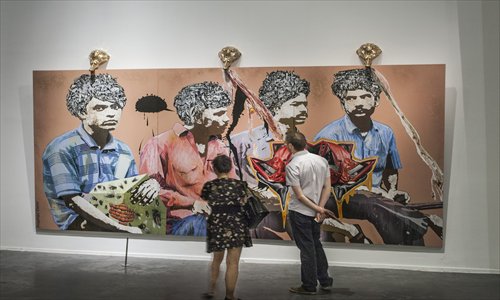For now, the focus shifts to India

Though China and India, geographical neighbors, bear similarities in their economic boom and social transformation, they are rarely grouped together in an artistic context.
But with India Highway, an exhibition of India's contemporary art running from June 24 to August 19 at the Ullens Center for Contemporary Art (UCCA), Chinese audiences have an opportunity to compare India's art development to the domestic scene.
The exhibition features nearly 30 influential Indian artists and their sculptures, paintings, videos and performances.
Organized by Serpentine Gallery, acclaimed modern art gallery in London, and Oslo's Astrup Fearnley Museet in Oslo, Norway, the Indian Highway exhibition premiered at the Serpentine Gallery in 2008.
The exhibition traveled to European institutions in the following three years. Beijing is the first stop in its Asia tour.
India's contemporary art
The exhibition brings together the art of 27 influential Indian contemporary artists, who examine complicated social and political issues like environmentalism, religious sectarianism, gender, and class in their work.
While bridging modern Indian and Chinese art is positive, some Chinese art insiders see this as a signal that UCCA, one of the leading and benchmarking collectors of Chinese contemporary art, is shifting its focus from China to India.
UCCA has focused on Chinese contemporary artists since the early 1980s. It once purchased works by artists like Ai Xuan, Wang Guangyi, and Fang Lijun when they were still largely unknown.
But when UCCA sold much of its Chinese art collections during last year's spring auction, suspicions were raised that the museum was distancing itself from the Chinese contemporary art market.
Besides the 106 pieces of artworks it entrusted Hong Kong Sotheby's to auction, Red Flag (1972) by Chinese artist Chen Yifei, and early works by Zhang Xiaogang and Fang Lijun were all auctioned at Beijing's Poly International Auction Co, Ltd.
Expanding focus
"We have been clarifying rumors [about losing interest in Chinese contemporary art] since last year," said Phillip Tinari, president of UCCA. "The situation is that we are still enthusiastic about Chinese art, but meanwhile we are developing a new interest in Indian art."
In the exhibition, there are two pieces from the collection of the Guy & Myriam Ullens Foundation including The Left-Over DNA of a Little Mouse by acclaimed Indian-British artist Bharti Kher.
"As two of the largest countries, China and India have many parallels," said Julia Peyton-Jones, director of Serpentine Gallery. But meanwhile, each country has its own distinguishing traits.
Peyton-Jones said that Indian artists touch upon social and economic issues more, as they operate on less restrictive terms. But Chinese art sells well, partly fueled by the increasing purchasing power of domestic consumers.
"In India, there are few organizations [that show] Indian art," said Peyton-Jones. "But in Beijing, we are in the center, [that] has the most extraordinary wide range of galleries you can see."
She added that China and India are now considerations for any international art exhibition.
In 2006, Serpentine Gallery premiered China Power Station, a major exhibition of contemporary Chinese Art.
"It's not the case at all that we are shifting our focus," said Hans Ulrich Obrist, co-director of Serpentine Gallery.
"Our interest for China has been going on a long time, for the past 20 years," said Hans. "It has become very trendy in the West to do a Chinese show and to do an Indian show; it's almost part of every portfolio."
He added that for large scale galleries like Serpentine Gallery and Astrup Fearnley Museet, the commitment to the Chinese and Indian art world is long-term, shown through large exhibitions China Power Station and India Highway .
"In the case of China, [which we've been focusing] for the past 20 years, for India, it's five years. Only recently have we engaged in this context," he said.
The Serpentine Gallery is now focusing on China, India and the Middle East. Peyton-Jones introduced that they have spent the past six years on a Middle East art project called Edgware Road.
Art bubble
Chinese artists seem assured in the meantime, by the commitment and enthusiasm of international collectors.
But with record-breaking auction results announced after each season's auction, some wonder if China's contemporary market can hold up.
UCCA's auction of Chinese art reflects China's art market bubble, which many fear will burst.
"Many pieces are over-priced. UCCA's move is like a test to the market," said Pi Li, director of Boers-Li Gallery in Beijing.
Compared to the large-scale collection of Chinese artwork in the late 1980s and 90s, UCCA is more cautious now.
Tinari said that 10 years ago, China's contemporary art was undervalued, with affordable prices.
"But now [collecting] is harder, since the market has both high and low quality work," said Tinari. This is coupled with rising market value and inflation.
But Tinari believes that the worst period for Chinese contemporary art has passed. He added that when he first stepped into the sector in 2000, people were worried that Chinese contemporary art market would lose its appeal to collectors, following Russia's art market in the 1990s.
"But the concern is not necessary," said Tinari. The current Chinese market is maturing, with systems and institutions in the chain developing, he said.